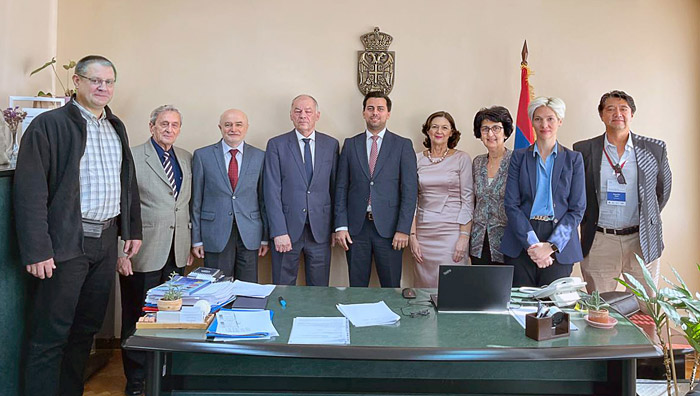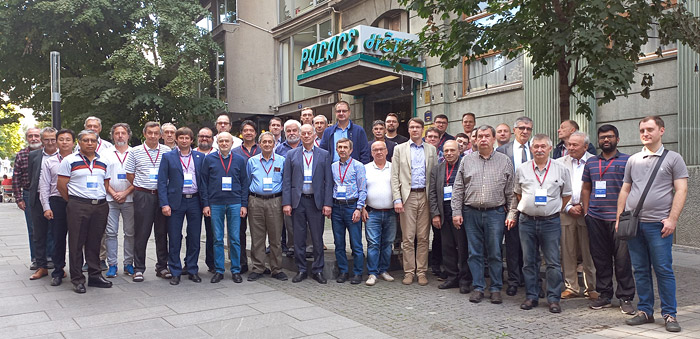
Electronic english version since 2022 |
The newspaper was founded in November 1957
| |
|
Number 38 (4686) |
JINR Days in Serbia
On 2-6 October, the JINR delegation was in Serbia. The visit programme included the School "NICA Days 2023" and the 12th collaboration meeting of the MPD experiment at the NICA facility. Both events were co-organized by the Serbian Vinca Institute of Nuclear Sciences that is also a member of the MPD collaboration. In addition, a number of meetings and discussions were held.
2 October. School for postgraduates and students
In a mixed format, the International School "NICA Days 2023" started at the Vinca Institute of Nuclear Sciences aimed at attracting new scientists and students to the development of the NICA accelerator complex.

JINR Vice-Director Vladimir Kekelidze spoke at the opening: "The NICA megascience project is implemented to shed light on the "blank spots" in our understanding of elementary particle physics, to really important issues in this area, such as, how do quarks operate, how do they behave, how are quarks part of a nucleon, how does the spin of a nucleon operate. To answer them, we need to build a modern accelerator complex, detectors and related infrastructure. There is a huge amount of data that needs to be accumulated and analyzed. And all this is a big goal: a whole range of complex tasks. The world's leading scientists will present ways to meet them in their reports at NICA Days. Hundreds of scientists and engineers are involved in the implementation of the NICA project. We hope that even more postgraduate students and young scientists will join this project..."
The participants were welcomed by Director of the Vinca Institute of Nuclear Sciences Snezana Pajovic. She noted that this year, the 75th anniversary of the Institute is celebrated: "International cooperation is a key component of the Institute's development. I would like to especially note that we are very proud of our established and already traditional cooperation with the Joint Institute for Nuclear Research. I am pleased to emphasize that in the year of our anniversary, scientists from the Vinca Institute "take part in the organization of NICA Days 2023. Serbian scientists participate in both the MPD and SPD collaborations. It opens up great opportunities for our science."
Postraduate students and students were presented with sixteen lectures from leading scientists, participants in the NICA megascience project: a brief overview of the current state of the project, the physical programme of the BM@N, MPD and SPD experiments, the ARIADNA programme for applied research. An overview of the main physical phenomena studied in collisions of heavy relativistic nuclei and the experimental methods used to measure the signals physicists are interested in were also provided in the lectures.
3 October. Strengthening scientific cooperation
A meeting of the JINR delegation with high-ranking representatives of the academic advising of the Republic of Serbia was held in Belgrade, at which a wide range of issues related to deepening scientific and practical cooperation between JINR and Serbian scientific organizations was discussed with the aim of gradually changing the status of Serbia in JINR from associate to full membership.
The participants of the meeting noted the great potential for deepening cooperation in the framework of joint fundamental scientific research in the field of relativistic heavy ion physics in the BM@N and MPD experiments at the NICA accelerator complex, the implementation of applied research within the ARIADNA project for the investiagtaion of life sciences, radiation materials science, testing electronics for radiation resistance and developing advanced nuclear energy technologies. In addition, great prospects were outlined for joint research in the areas of nuclear medicine, development and production of microelectronics for scientific research.
The historically warm and close ties between JINR and Serbia were noted, as well as the positive experience of the participation of specialists from Serbia in the MPD experiment, where they study collective effects in collisions of heavy nuclei through measuring many-particle correlations. Proposals were made to increase the mobility of groups participating in joint research and to carry out student exchanges to more effectively attract young specialists to currently implemented research. In conclusion, the need to organize regular meetings and to maintain constant contacts between the parties was noted.
From the Serbian side, the State Secretary of the Ministry of Education, Science and Technological Development Vukacin Grozdic with Senior Advisor Svetlana Bogdanovich, Director of the Vinca Institute of Nuclear Sciences Snezana Pajovich, as well as Acting Assistant Minister of International Cooperation and European Integration Ivana Vukasinovich took part in the meeting. Vice-Director of the Joint Institute Vladimir Kekelidze, VBLHEP Deputy Director for Research Alexander Sorin, Chairman of the JINR Programme Advisory Committee on Particle Physics Yitzhak Tserruya, Chairman of the Council of MPD Collaboration Institutes Alejandro Ayala, Head of the MPD Collaboration Viktor Ryabov, as well as a representative of the Department of International Cooperation of JINR Olga Korotchik participated on behalf of JINR.

4 October. MPD collaboration meeting
The 12th collaboration meeting of the MPD experiment at the NICA facility started at the Vinca Institute of Nuclear Sciences in Belgrade. In the reports of the first day, it was noted that the project successfully overcomes difficulties caused by external circumstances. The first test launches of the collider are still expected for 2024. A slight shift in the timing of the start of the data set in collider mode is necessary for the mid-2025. More than 120 participants from research centres in Bulgaria, Georgia, Egypt, Israel, China, Mexico, Mongolia, Russia and Serbia participated in the event.
Opening the event, the NICA project leader Vladimir Kekelidze highlighted the successful outcome of the longest commissioning session in the history of the experiment, completed in February of this year. "For the first time, all components of the accelerator complex operated harmoniously for more than four thousand hours. As a result of the session, the BM@N collaboration accumulated more than half a billion events that means the first physics programme at NICA has started," he noted. Vladimir Kekelidze also reported that most of the collider magnets are ready and 80 dipole magnets have already been installed in the tunnel arches. Construction work at the complex is close to completion and the delivery of engineering equipment is expected. The cryogenic complex of the NICA project will be put into operation within a few months. "Despite the fact that due to external circumstances, difficulties occur with the supply of finished equipment and the implementation of contract terms by our colleagues, the MPD collaboration successfully finds solutions to these tasks and the project develops," V. Kekelidze added. He also emphasized that the NICA project leaders decided to postpone the start date of the collider data set from the end of this year to mid-2025.
A member of the governing council of the Vinca Institute of Nuclear Sciences Ljupco Hadzievski spoke at the meeting. "Despite the difficulties that occur, we are always happy to find new ways to strengthen our collaboration and are ready to assist our colleagues from JINR. One of the results of our support was the organization of this meeting here in Belgrade," he emphasized.
The chief engineer of the facility Evgeny Syresin spoke about the status and plans of the NICA megascience project. A technical launch of the collider is expected for late summer - early autumn 2024 to test the operation of the cryomagnetic system. At the end of 2024, xenon and bismuth ion beams will be launched at the collider. One of the reasons for the postponement of the launch date of the collider was the delay in the supply of finished equipment for the transfer line of beams from the Nuclotron to the collider: power supplies, beam diagnostic systems, vacuum chambers, others. The development and production of new required equipment components will be carried out by the Joint Institute in the next year.
The current status of the collaboration and progress in the implementation of the MPD project was presented in his report by collaboration spokesman Viktor Ryabov (PNPI). The project already brings together more than 500 participants from 35 institutes in 11 countries. During the previous collaboration meeting, the Institutional Council selected VBLHEP leading researcher Arkady Taranenko as deputy leader of the MPD collaboration. In addition, two new scientific organizations St. Petersburg Polytechnic University and the Institute of Physics and Technology (Almaty, Kazakhstan) have joined the collaboration.
All components required to implement Stage 1 of the MPD experiment are widely developed and tested. Reports on each system of the MPD experimental facility were presented at the meeting. The participants discussed the software and computing infrastructure of the detector and the reconstruction of events in the experiment. Reports from working groups on the work carried out were presented.
5 October. Meeting at the embassy
A meeting of the delegation of the Joint Institute for Nuclear Research with the representatives of the Embassy of the Russian Federation in Serbia was held in Belgrade. Ambassador Extraordinary and Plenipotentiary of the Russian Federation to Serbia Alexander Botsan-Kharchenko and JINR Vice-Director Vladimir Kekelidze discussed various aspects of cooperation between JINR and Serbia. The parties focused on the topics of nuclear medicine, participation in the NICA megaproject, as well as cooperation in the field of education and training of scientific personnel.
Minister Counselor of the Russian Embassy in Serbia Andrey Temyashov and VBLHEP Deputy Director for Research Alexander Sorin took part in the meeting.
Vladimir Kekelidze told the diplomats about the working programme of the delegation of the Joint Institute and introduced the history of the development of cooperation between JINR and Serbia. It was emphasized that at the moment, the parties are widely involved in the expansion of Serbia's participation in JINR and are mutually interested in raising it to full membership. Alexander Botsan-Kharchenko, on behalf of the Embassy of the Russian Federation in Serbia, expressed his intention to provide assistance on this issue.
The parties discussed the areas of possible cooperation between JINR and Serbia. Student practices and internships at JINR facilities and cooperation in the field of teacher training in natural sciences are of great interest. Serbia's participation in the ARIADNA collaboration on applied research at NICA was identified as another possible area of joint activity. In addition, cooperation in the field of nuclear medicine for the treatment of cancer is relevant. Thus, the development of a prototype of the superconducting medical proton cyclotron MSC-230 for radiation therapy at JINR is underway. The possibility of JINR specialists developing such a cyclotron is of great interest to each Member State of the Institute, including Serbia.
Vladimir Kekelidze invited Alexander Botsan-Kharchenko to pay a return visit to Dubna.
Based on the information from the JINR Press Office